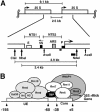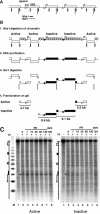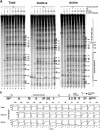RNA polymerase I transcription factors in active yeast rRNA gene promoters enhance UV damage formation and inhibit repair
- PMID: 15713619
- PMCID: PMC549387
- DOI: 10.1128/MCB.25.5.1586-1595.2005
RNA polymerase I transcription factors in active yeast rRNA gene promoters enhance UV damage formation and inhibit repair
Abstract
UV photofootprinting and repair of pyrimidine dimers by photolyase was used to investigate chromatin structure, protein-DNA interactions, and DNA repair in the spacer and promoter of Saccharomyces cerevisiae rRNA genes. Saccharomyces cerevisiae contains about 150 copies of rRNA genes separated by nontranscribed spacers. Under exponential growth conditions about half of the genes are transcribed by RNA polymerase I (RNAP-I). Initiation of transcription requires the assembly of the upstream activating factor (UAF), the core factor (CF), TATA binding protein, and RNAP-I with Rrn3p on the upstream element and core promoter. We show that UV irradiation of wild-type cells and transcription factor mutants generates photofootprints in the promoter elements. The core footprint depends on UAF, while the UAF footprint was also detected in absence of the CFs. Fractionation of active and inactive promoters showed the core footprint mainly in the active fraction and similar UAF footprints in both fractions. DNA repair by photolyase was strongly inhibited in active promoters but efficient in inactive promoters. The data suggest that UAF is present in vivo in active and inactive promoters and that recruitment of CF and RNAP-I to active promoters generates a stable complex which inhibits repair.
Figures






Similar articles
-
TATA-binding protein promotes the selective formation of UV-induced (6-4)-photoproducts and modulates DNA repair in the TATA box.EMBO J. 1999 Jan 15;18(2):433-43. doi: 10.1093/emboj/18.2.433. EMBO J. 1999. PMID: 9889199 Free PMC article.
-
Poly(dA.dT) sequences exist as rigid DNA structures in nucleosome-free yeast promoters in vivo.Nucleic Acids Res. 2000 Nov 1;28(21):4083-9. doi: 10.1093/nar/28.21.4083. Nucleic Acids Res. 2000. PMID: 11058103 Free PMC article.
-
Chromatin structure modulates DNA repair by photolyase in vivo.EMBO J. 1997 Apr 15;16(8):2150-60. doi: 10.1093/emboj/16.8.2150. EMBO J. 1997. PMID: 9155040 Free PMC article.
-
Nucleosome positioning, nucleotide excision repair and photoreactivation in Saccharomyces cerevisiae.DNA Repair (Amst). 2015 Dec;36:98-104. doi: 10.1016/j.dnarep.2015.09.012. Epub 2015 Sep 16. DNA Repair (Amst). 2015. PMID: 26429065 Review.
-
Repair of UV induced DNA lesions in ribosomal gene chromatin and the role of "Odd" RNA polymerases (I and III).DNA Repair (Amst). 2015 Dec;36:49-58. doi: 10.1016/j.dnarep.2015.09.007. Epub 2015 Sep 10. DNA Repair (Amst). 2015. PMID: 26411875 Review.
Cited by
-
Chromosome XII context is important for rDNA function in yeast.Nucleic Acids Res. 2006 May 31;34(10):2914-24. doi: 10.1093/nar/gkl293. Print 2006. Nucleic Acids Res. 2006. PMID: 16738130 Free PMC article.
-
Genome-wide maps of UV damage repair and mutation suppression by CPD photolyase.Nucleic Acids Res. 2025 Jun 6;53(11):gkaf495. doi: 10.1093/nar/gkaf495. Nucleic Acids Res. 2025. PMID: 40498072 Free PMC article.
-
Clustered somatic mutations are frequent in transcription factor binding motifs within proximal promoter regions in melanoma and other cutaneous malignancies.Oncotarget. 2016 Oct 11;7(41):66569-66585. doi: 10.18632/oncotarget.11892. Oncotarget. 2016. PMID: 27611953 Free PMC article.
-
Ribosomal DNA status inferred from DNA cloud assays and mass spectrometry identification of agarose-squeezed proteins interacting with chromatin (ASPIC-MS).Oncotarget. 2017 Apr 11;8(15):24988-25004. doi: 10.18632/oncotarget.15332. Oncotarget. 2017. PMID: 28212567 Free PMC article.
-
Transcription of multiple yeast ribosomal DNA genes requires targeting of UAF to the promoter by Uaf30.Mol Cell Biol. 2008 Nov;28(21):6709-19. doi: 10.1128/MCB.00703-08. Epub 2008 Sep 2. Mol Cell Biol. 2008. PMID: 18765638 Free PMC article.
References
-
- Becker, M. M., and J. C. Wang. 1984. Use of light for footprinting DNA in vivo. Nature 309:682-687. - PubMed
Publication types
MeSH terms
Substances
LinkOut - more resources
Full Text Sources
Molecular Biology Databases
